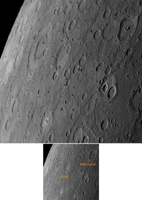
Click on image for
larger annotated versionMESSENGER snapped this image of Mercury’s horizon about 56 minutes before the spacecraft’s closest pass by the planet. The distinctive peak-ring basin Dürer (named from Mariner 10 photos for the German artist Albrecht Dürer) is visible. The smaller crater Mickiewicz (named for the Polish poet Adam Mickiewicz) can also be seen, with a smaller central peak-ring structure in the middle of its crater floor. Craters form ring structures during the impact process that creates the crater, and the number and characteristics of the rings depend on the crater’s size. Raditladi, imaged for the first time by MESSENGER and recently named, also shows a pronounced peak-ring structure.
Date Acquired: January 14, 2008
Image Mission Elapsed Time (MET): 108821505
Instrument: Narrow Angle Camera (NAC) of the Mercury Dual Imaging System (MDIS)
Scale: Dürer crater is about 190 kilometers (120 miles) in diameter
Spacecraft Altitude: 18,300 kilometers (11,400 miles)
These images are from MESSENGER, a NASA Discovery mission to conduct the first orbital study of the innermost planet, Mercury. For information regarding the use of images, see the MESSENGER image use policy.

